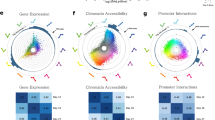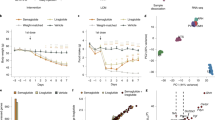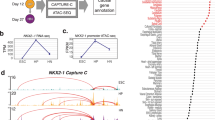Abstract
Genome-wide association studies in obesity have identified a large number of non-coding loci located near genes expressed in the central nervous system. However, due to the difficulties in isolating and characterizing specific neuronal subpopulations, few obesity-associated single-nucleotide polymorphisms have been functionally characterized. Leptin-responsive neurons in the hypothalamus are essential in controlling energy homoeostasis and body weight. Here, we combine fluorescence-activated cell sorting of leptin-responsive hypothalamic neuron nuclei with genomic and epigenomic approaches (RNA sequencing, chromatin immunoprecipitation sequencing, assay for transposase-accessible chromatin sequencing) to generate a comprehensive map of leptin response-specific regulatory elements, several of which overlap obesity-associated genome-wide association study variants. We demonstrate the usefulness of our leptin response neuron regulome, by functionally characterizing an enhancer near Socs3, a leptin response-associated transcription factor. We envision our data to serve as a useful resource and a blueprint for functionally characterizing obesity-associated single-nucleotide polymorphisms in the hypothalamus.
This is a preview of subscription content, access via your institution
Access options
Access Nature and 54 other Nature Portfolio journals
Get Nature+, our best-value online-access subscription
$29.99 / 30 days
cancel any time
Subscribe to this journal
Receive 12 digital issues and online access to articles
$119.00 per year
only $9.92 per issue
Buy this article
- Purchase on Springer Link
- Instant access to full article PDF
Prices may be subject to local taxes which are calculated during checkout






Similar content being viewed by others
Data availability
The RNA-seq data are available in NCBI BioProject PRJNA439388. ChIP-seq and ATAC-seq data are available in NCBI Bioproject PRJNA439388. The data that support the findings of this study are available from the corresponding author upon request.
Change history
01 March 2024
A Correction to this paper has been published: https://doi.org/10.1038/s42255-023-00953-1
References
Must, A. et al. The disease burden associated with overweight and obesity. JAMA 282, 1523–1529 (1999).
Berrington de Gonzalez, A. et al. Body-mass index and mortality among 1.46 million white adults. N. Engl. J. Med. 363, 2211–2219 (2010).
Ogden, C. L., Carroll, M. D., Fryar, C. D. & Flegal, K. M. Prevalence of obesity among adults and youth: United States, 2011–2014. NCHS Data Brief 219, 1–8 (2015).
Swinburn, B. A. et al. The global obesity pandemic: shaped by global drivers and local environments. Lancet 378, 804–814 (2011).
Stunkard, A. J., Foch, T. T. & Hrubec, Z. A twin study of human obesity. JAMA 256, 51–54 (1986).
Stunkard, A. J. et al. An adoption study of human obesity. New Engl. J. Med. 314, 193–198 (1986).
Silventoinen, K., Rokholm, B., Kaprio, J. & Sørensen, T. I. The genetic and environmental influences on childhood obesity: a systematic review of twin and adoption studies. Int. J. Obesity (Lond.) 34, 29–40 (2010).
Albuquerque, D., Stice, E., Rodríguez-López, R., Manco, L. & Nóbrega, C. Current review of genetics of human obesity: from molecular mechanisms to an evolutionary perspective. Mol. Genet. Genomics 290, 1191–1221 (2015).
Münzberg, H. & Myers, M. G. Jr. Molecular and anatomical determinants of central leptin resistance. Nat. Neurosci. 8, 566–570 (2005).
Turcot, V. et al. Protein-altering variants associated with body mass index implicate pathways that control energy intake and expenditure in obesity. Nat. Genet. 50, 26–41 (2018).
Locke, A. E. et al. Genetic studies of body mass index yield new insights for obesity biology. Nature 518, 197–206 (2015).
Ghosh, S. & Bouchard, C. Convergence between biological, behavioural and genetic determinants of obesity. Nat. Rev. Genet. 18, 731–748 (2017).
Dermitzakis, E. T. From gene expression to disease risk. Nat. Genet. 40, 492–493 (2008).
Schaub, M. A., Boyle, A. P., Kundaje, A., Batzoglou, S. & Snyder, M. Linking disease associations with regulatory information in the human genome. Genome Res. 22, 1748–1759 (2012).
Maurano, M. T. et al. Systematic localization of common disease-associated variation in regulatory DNA. Science 337, 1190–1195 (2012).
Heintzman, N. D. et al. Histone modifications at human enhancers reflect global cell-type-specific gene expression. Nature 459, 108–112 (2009).
Chen, R., Wu, X., Jiang, L. & Zhang, Y. Single-cell RNA-seq reveals hypothalamic cell diversity. Cell Rep. 18, 3227–3241 (2017).
Leshan, R. L., Björnholm, M., Münzberg, H. & Myers, M. G. Jr. Leptin receptor signaling and action in the central nervous system. Obesity (Silver Spring) 14, 208S–212S (2006).
Mo, A. et al. Epigenomic signatures of neuronal diversity in the mammalian brain. Neuron 86, 1369–1384 (2015).
Langfelder, P. & Horvath, S. WGCNA: an R package for weighted correlation network analysis. BMC Bioinformatics 9, 559 (2008).
Cady, G. et al. Hypothalamic growth hormone receptor (GHR) controls hepatic glucose production in nutrient-sensing leptin receptor (LepRb) expressing neurons. Mol. Metab. 6, 393–405 (2017).
Allison, M. B. et al. TRAP-seq defines markers for novel populations of hypothalamic and brainstem LepRb neurons. Mol. Metab. 4, 299–309 (2015).
Allison, M. B. et al. Defining the transcriptional targets of leptin reveals a role for Atf3 in leptin action. Diabetes 67, 1093–1104 (2018).
Howard, J. K. & Flier, J. S. Attenuation of leptin and insulin signaling by SOCS proteins. Trends Endocrin. Met. 17, 365–371 (2006).
Schick, N., Oakeley, E. J., Hynes, N. E. & Badache, A. TEL/ETV6 is a signal transducer and activator of transcription 3 (Stat3)-induced repressor of Stat3 activity. J. Biol. Chem. 279, 38787–38796 (2004).
Valentino, M. A. et al. A uroguanylin-GUCY2C endocrine axis regulates feeding in mice. J. Clin. Invest. 121, 3578–3588 (2011).
McLean, C. Y. et al. GREAT improves functional interpretation of cis-regulatory regions. Nat. Biotechnol. 28, 495–501 (2010).
Machanick, P. & Bailey, T. L. MEME-ChIP: motif analysis of large DNA datasets. Bioinformatics 27, 1696–1697 (2011).
Nazarians-Armavil, A., Chalmers, J. A., Lee, C. B., Ye, W. & Belsham, D. D. Cellular insulin resistance disrupts hypothalamic mHypoA-POMC/GFP neuronal signaling pathways. J. Endocrinol. 220, 13–24 (2014).
Gilbert, L. A. et al. Genome-scale CRISPR-mediated control of gene repression and activation. Cell 159, 647–661 (2014).
Chang, C. C. et al. Second-generation PLINK: rising to the challenge of larger and richer datasets. Gigascience 4, 7 (2015).
Dunham, I. et al. An integrated encyclopedia of DNA elements in the human genome. Nature 489, 57–74 (2012).
Olza, J. et al. Leptin receptor gene variant rs11804091 is associated with BMI and insulin resistance in Spanish female obese children: a case-control study. Int. J. Mol. Sci. 18, E1690 (2017).
Lonsdale, J. et al. The Genotype-Tissue Expression (GTEx) project. Nat. Genet. 45, 580–585 (2013).
Kublaoui, B. M., Gemelli, T., Tolson, K. P., Wang, Y. & Zinn, A. R. Oxytocin deficiency mediates hyperphagic obesity of Sim1 haploinsufficient mice. Mol. Endocrinol. 22, 1723–1734 (2008).
Kublaoui, B. M., Holder, J. L. Jr., Tolson, K. P., Gemelli, T. & Zinn, A. R. SIM1 overexpression partially rescues agouti yellow and diet-induced obesity by normalizing food intake. Endocrinology 147, 4542–4549 (2006).
Beuckmann, C. T. et al. Expression of a poly-glutamine-ataxin-3 transgene in orexin neurons induces narcolepsy-cataplexy in the rat. J. Neurosci. 24, 4469–4477 (2004).
Dobin, A. et al. STAR: ultrafast universal RNA-seq aligner. Bioinformatics 29, 15–21 (2013).
Love, M. I., Huber, W. & Anders, S. Moderated estimation of fold change and dispersion for RNA-seq data with DESeq2. Genome Biol. 15, 550 (2014).
Dennis, G. Jr. et al. DAVID: Database for Annotation, Visualization, and Integrated Discovery. Genome Biol. 4, P3 (2003).
Fresno, C. & Fernández, E. A. RDAVIDWebService: a versatile R interface to DAVID. Bioinformatics 29, 2810–2811 (2013).
Langmead, B., Trapnell, C., Pop, M. & Salzberg, S. L. Ultrafast and memory-efficient alignment of short DNA sequences to the human genome. Genome Biol. 10, R25 (2009).
Zhang, Y. et al. Model-based analysis of ChIP-Seq (MACS). Genome Biol. 9, R137 (2008).
Landt, S. G. et al. ChIP-seq guidelines and practices of the ENCODE and modENCODE consortia. Genome Res. 22, 1813–1831 (2012).
Quinlan, A. R. & Hall, I. M. BEDTools: a flexible suite of utilities for comparing genomic features. Bioinformatics 26, 841–842 (2010).
Anders, S., Pyl, P. T. & Huber, W. HTSeq: a Python framework to work with high-throughput sequencing data. Bioinformatics 31, 166–169 (2015).
Buenrostro, J. D., Giresi, P. G., Zaba, L. C., Chang, H. Y. & Greenleaf, W. J. Transposition of native chromatin for fast and sensitive epigenomic profiling of open chromatin, DNA-binding proteins and nucleosome position. Nat. Methods 10, 1213–1218 (2013).
Langmead, B. & Salzberg, S. L. Fast gapped-read alignment with Bowtie 2. Nat. Methods 9, 357–359 (2012).
Auton, A. et al. A global reference for human genetic variation. Nature 526, 68–74 (2015).
Battle, A., Brown, C. D., Engelhardt, B. E. & Montgomery, S. B. Genetic effects on gene expression across human tissues. Nature 550, 204–213 (2017).
Acknowledgements
We thank J. Tollkuhn (CSHL) for critical advice and M. Myers (University of Michigan) for sharing the LepRb TRAP-seq data. We also thank A. Hardin and S. Rattanasopha for help with the dissections and M. Cavrois and M. Maiti for assistance with FACS. This article was supported in part by a grant from the National Institute of Diabetes and Digestive and Kidney Diseases (grant no. 1R01DK090382 to N.A. and C.V.) and the University of California, San Francisco Nutrition Obesity Research Center funded by the National Institute of Health (grant no. P30DK098722). N.A. is also supported by grants from the National Human Genome Research Institute (NHGRI) and Division of Cancer Prevention, National Cancer Institute grant no. 1R01CA197139, National Institute of Mental Health grant no. 1R01MH109907, National Institute of Child and Human Development grant no. 1P01HD084387, NHGRI grant no. 1UM1HG009408 and National Heart, Lung, and Blood Institute grant no. 1R01HL138424. The Gladstone Institute Flow Cytometry Core is supported by National Institutes of Health (NIH) grant no. P30 AI027763 for using LSR2, Calibur, VYB, Aria, HTFC and ImageStream, NIH grant no. S10 RR028962 and the James B. Pendleton Charitable Trust for using the FACSAria cell sorter, and Department of Defense grant no. W81XWH-11-1-0562 for using ImageStream.
Author information
Authors and Affiliations
Contributions
F.I., C.V. and N.A. conceived and designed the study. F.I. performed the mouse, genomic and enhancer experiments. K.K.M. and N.M. helped with the mouse dissections. Y.W. carried out the immunostaining and W.L.E. performed the computational analyses. F.I., W.L.E., C.V. and N.A. analysed the data. C.V. and N.A. provided resources and critical suggestions. F.I., W.L.E., C.V. and N.A. wrote the manuscript.
Corresponding authors
Ethics declarations
Competing interests
The authors declare no competing interests.
Additional information
Publisher’s note: Springer Nature remains neutral with regard to jurisdictional claims in published maps and institutional affiliations.
Supplementary information
Supplementary Information
Supplementary Figures 1–6 and Supplementary Tables 1 and 4
Supplementary Table 2
Transcription factor binding site analyses of H3K27ac ChIP-seq and ATAC-seq peaks
Supplementary Table 3
Obesity GWAS SNPs overlapping mouse ChIP-seq and ATAC-seq lifted-over peak regions
Supplementary Data 1
RNA-seq results. This file contains a table of RNA-seq results for all genes in the Ensembl annotation and all lncRNAs, including gene annotation information, location, average expression, expression per sample and differential expression test results for all comparisons.
Supplementary Data 2
ChIP-seq and ATAC-seq results. This file contains a table of ChIP-seq and ATAC-seq results for all peaks including annotation information, location, average enrichment, enrichment per sample and differential expression test results for all comparisons.
Supplementary Data 3
eQTL analyses of H3K27ac ChIP-seq and ATAC-seq peaks. This file contains a table of ChIP-seq and ATAC-seq results for all peaks and includes nearest gene annotation information, and obesity-associated variant overlap information, plus peak location, average enrichment, enrichment per sample and differential expression test results for all comparisons.
Rights and permissions
About this article
Cite this article
Inoue, F., Eckalbar, W.L., Wang, Y. et al. Genomic and epigenomic mapping of leptin-responsive neuronal populations involved in body weight regulation. Nat Metab 1, 475–484 (2019). https://doi.org/10.1038/s42255-019-0051-x
Received:
Accepted:
Published:
Issue Date:
DOI: https://doi.org/10.1038/s42255-019-0051-x
This article is cited by
-
A genetic map of the mouse dorsal vagal complex and its role in obesity
Nature Metabolism (2021)
-
Cis-regulatory architecture of human ESC-derived hypothalamic neuron differentiation aids in variant-to-gene mapping of relevant complex traits
Nature Communications (2021)
-
Mapping leptin-responsive neurons in the hypothalamus
Nature Reviews Endocrinology (2019)



